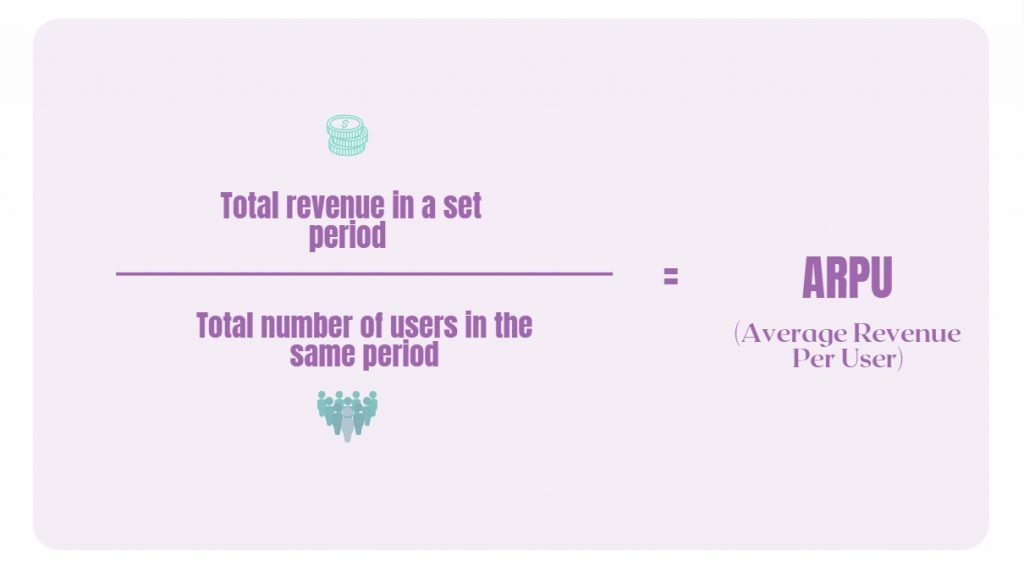What is ARPU?
ARPU signifies the average income generated by individual users within a specific timeframe. In mobile app and gaming marketing, it serves as a crucial metric, indicating the effectiveness of monetization strategies.
ARPU Meaning
Average Revenue Per User (ARPU) serves as a pivotal metric across various industries, predominantly in subscription-based models. ARPU quantifies the average revenue generated by individual users or customers within a specified time frame, commonly calculated monthly or annually. This metric's adaptability extends beyond its roots in the telecom industry, making it invaluable in understanding the financial health of businesses in diverse sectors.
Who Uses Average Revenue Per Unit (ARPU)?
ARPU acts as a guiding compass for decision-makers, providing quantifiable insights that steer crucial business strategies towards sustained growth and improved revenue streams.
Utilizing ARPU metrics in decision-making involves a multifaceted approach. It informs strategies for product improvements or feature additions aimed at increasing revenue per user. ARPU insights also guide decisions regarding customer segmentation, helping businesses target high-value users for specialized marketing initiatives. Moreover, ARPU trends aid in setting competitive pricing structures and evaluating the feasibility of new business models.
To gain a comprehensive understanding of your market and competitors' strategies, leverage SocialPeta's Ad Intelligence functionality. Explore advertising data across diverse channels and optimize your marketing strategies for heightened success.
Spy on Top Ads, For Your Apps
Register For Free DemoHow to Calculate ARPU?(ARPU Revenue Formula)
The ARPU Revenue Formula involves a simple yet pivotal calculation: dividing the total revenue earned within a specific period by the number of active users.
Let's explore this calculation through an example:
Suppose an app generated a total monthly revenue of $50,000 and had 500 active subscribers during that month:
ARPU = Total Monthly Revenue / Total Number of Active Subscribers
ARPU = $50,000 / 500
ARPU = $100 per user per month
However, the nuances in this calculation lie in defining "active users" and the precise revenue considered.
For mobile apps and gaming, active users encompass those engaged within the app or game during the stipulated time frame. It excludes dormant or inactive users. Revenue comprises all income sources—be it in-app purchases, subscriptions, ad revenue, or other monetization avenues.
Implementing analytics tools like SocialPeta's Ad Intelligence can streamline data gathering, providing a comprehensive understanding of revenue streams and user behavior. This clarity aids in refining marketing strategies to optimize ARPU.

What is Good ARPU?
Determining what constitutes a "Good" ARPU varies significantly across industries, business models, and market dynamics. It represents a benchmark figure that ensures sustainable profitability while promoting growth.
For instance, in the technology sector, a "Good" ARPU might hover around $100 to $300 per user monthly, ensuring adequate revenue to cover operational costs and foster expansion. Conversely, industries like media or gaming might have different benchmarks due to varying monetization strategies.
To comprehend what qualifies as a "Good" ARPU, businesses often benchmark against industry standards or competitors. Analyzing industry-specific averages or reviewing competitors' ARPU provides valuable insights into performance relative to the market. For instance, if a company's ARPU falls below the industry average, it might signal a need for pricing adjustments or strategic repositioning to enhance revenue generation per user.
How to Improve ARPU?
Improving ARPU is pivotal for sustained business growth and profitability. Businesses can employ various strategies to bolster ARPU, including:
- Pricing Structure Refinement: Analyzing and optimizing pricing plans to offer value-driven options that prompt users to upgrade to higher-tier subscriptions.
- Upselling High-Value Products/Services: Identifying opportunities to introduce premium features or additional services to existing users, encouraging them to spend more within the platform.
- Enhancing Customer Engagement and Retention: Fostering stronger relationships with users through personalized experiences, targeted promotions, and loyalty programs to increase their spending and long-term commitment.
ARPU vs. ARPPU vs. LTV: Distinguishing Key Metrics
ARPU vs. ARPPU
ARPU (Average Revenue Per User) measures the average revenue generated per user over a specific period, providing an overall snapshot of revenue generation. On the other hand, ARPPU (Average Revenue Per Paid User) focuses solely on revenue derived from paying customers, excluding free or trial users. ARPPU gives insights into the spending behavior of customers who have committed to paid services.
ARPU vs. LTV
ARPU evaluates the average revenue generated per user, offering immediate insights into short-term revenue performance. Conversely, LTV (Customer Lifetime Value) estimates the total net value a customer brings throughout their entire engagement with a business. While ARPU helps understand current revenue streams, LTV considers long-term profitability and aids in assessing customer acquisition and retention strategies.
For mobile apps and gaming, ARPU measures short-term financial viability, whereas LTV encompasses long-term profitability. Striking a balance between these metrics is pivotal. A high ARPU coupled with a low LTV may imply unsustainable growth, emphasizing the need for a robust user retention strategy.
